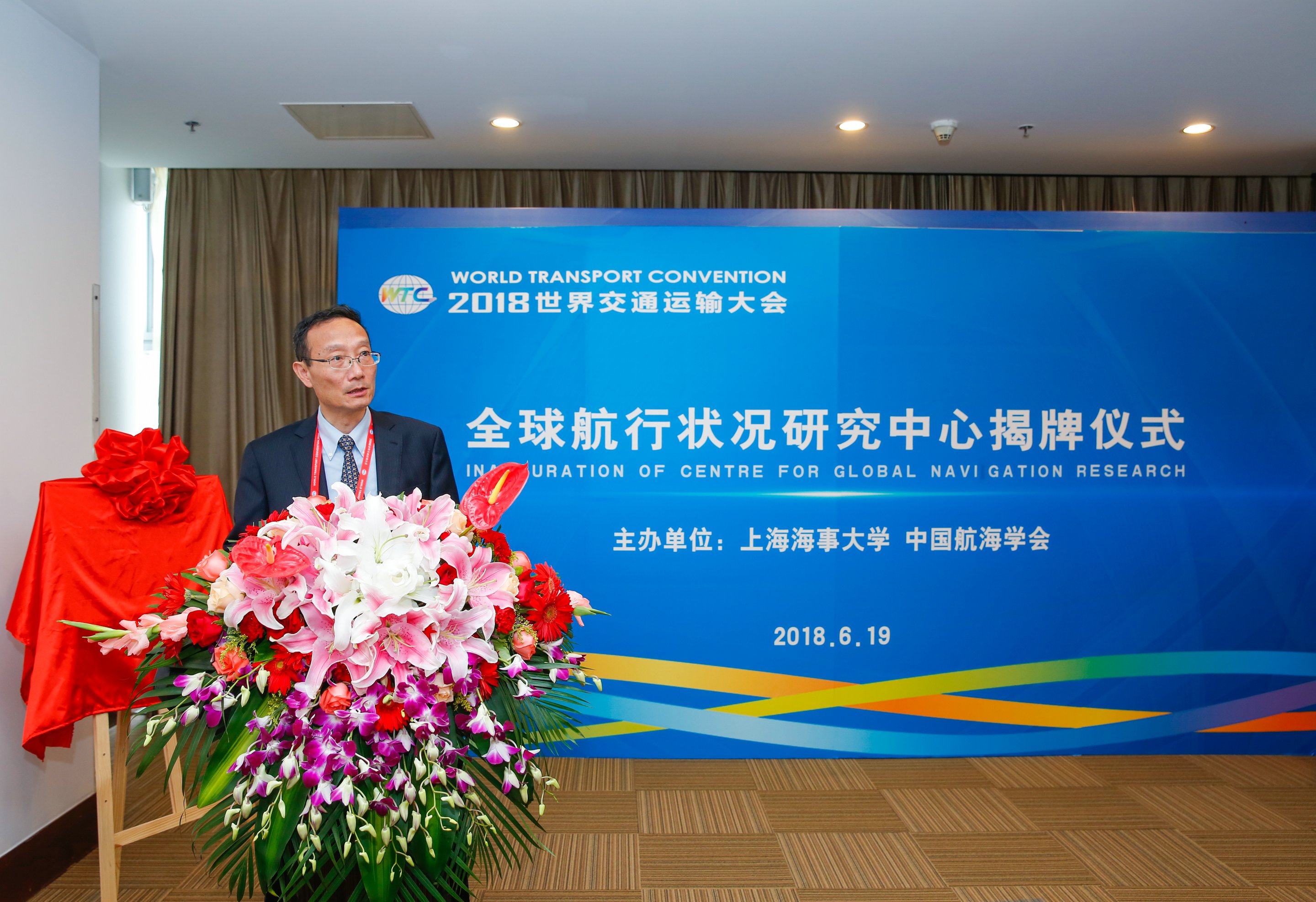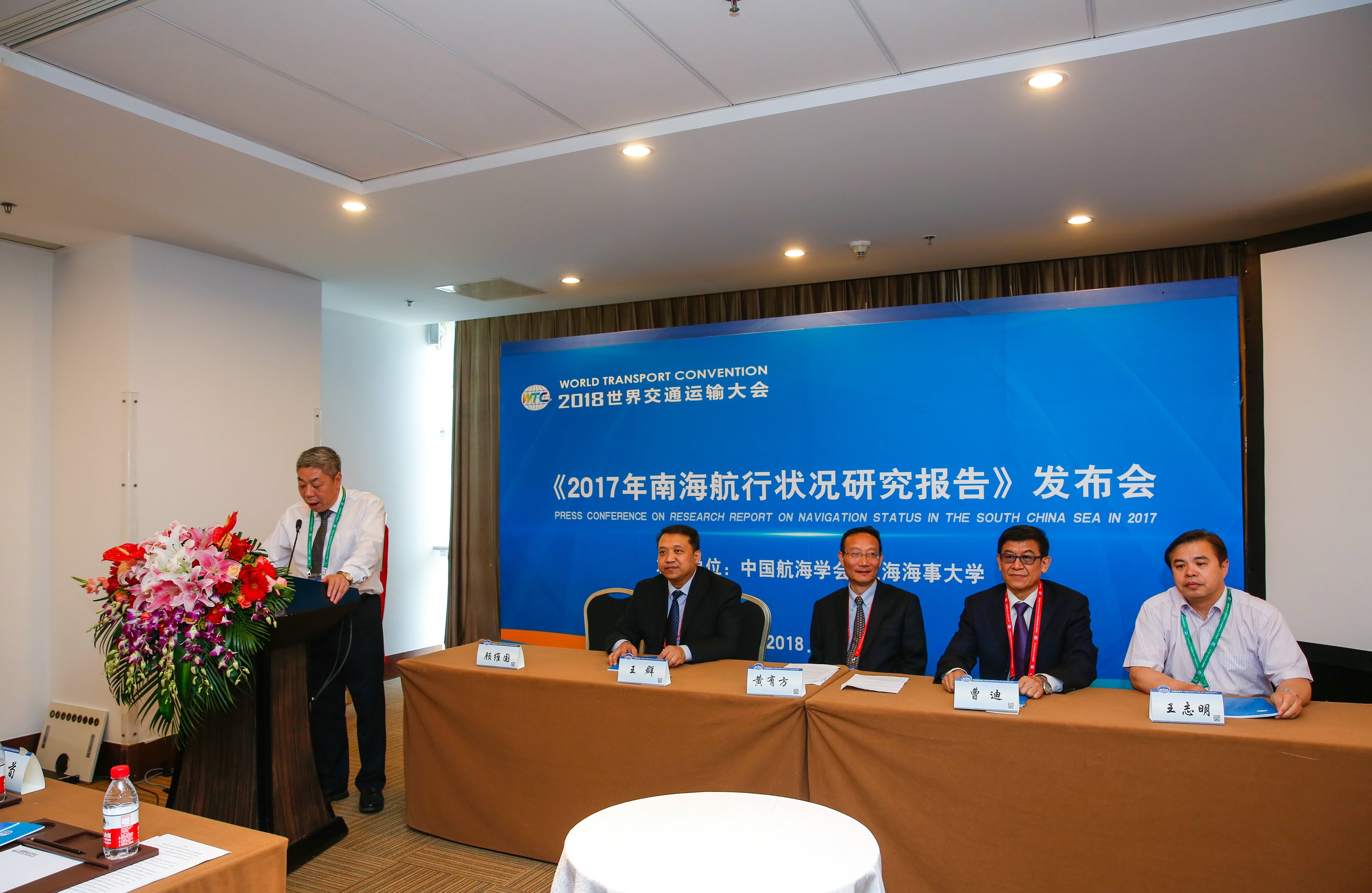On the afternoon of 19th June, Press Conference on Research Report on Navigation Status in the South China Sea, 2017, hosted by China Institute of Navigation, was held at 2018 World Transport Convention in Beijing. Research Report on Navigation Status in the South China Sea, 2017 was issued by the collaboration of the experts and academics from China Institute of Navigation and Shanghai Maritime University.

China Institute of Navigation and Shanghai Maritime University have conducted a comprehensive and objective analysis and argument on the actual safety status of ship navigation in the South China Sea for two consecutive years. The research group analyzed and concluded the security status of navigation in the South China Sea by the collected data on reefs, channels, navigation rules, weather system and recommended routes in the South China Sea. Based on the collection, counting and analysis on big data of satellite AIS, they got the fundamental statistics on the ship transportation in the South China Sea and made a comparison on the route map and conventional navigation rules in the South China Sea. The report demonstrated that merchant ships, regardless of nationality, area could stably, smoothly and freely sail in the South China Sea during the voyage without interference and route choice and navigation for merchant ship are free and safe.

At the press conference, Huang Youfang, Chairman of China Institute of Navigation (CIN) and President of Shanghai Maritime University, pointed out that during the past year, experts and academics from Shanghai Maritime University, major institutions and academic support organization and China Institute of Navigation, have researched in the following three aspects:
First, recommended routes and maps in the South China Sea are made according to Ocean Passage for the World, an authoritative reference on navigation in Britain, and navigational practice. This research shows that the recommended route in the South China Sea mainly applies to the merchant ships sailing to and from the ports of China, Japan, Korea, Southeast Asia and the western countries, except for fisheries activities. The routes run mainly from the southwest to the northeast. Considering season, these routes can be divided into three routes including the east, the west and the middle which is the key route. The report also shows that the three recommended routes above-mentioned can ensure the safe shipping as there is a safe distance from the reef area.
Second, the analysis and research on satellite AIS data of ship flow in the South China Sea is done quantitatively and qualitatively. According to the statistics and analysis of vessel numbers, the total number of vessels in the South China Sea is 7,909 and 7,502 in March and June 2017 respectively, in which the deadweight of vessel is mainly above 30,000 and monthly vessel numbers is much the same as that of 2016. Excluding weather (tropical storm) impact, energy saving and speed control, ships can freely and smoothly sail. The recommended routes for merchant ships in the South China Sea are chosen repeatedly and freely by ships navigating in this water area. The traffic, length, breadth and draft of the ship are generally large and the ship's speed is stable on average. Ports of registry are owned by nearly 70(64~68) major countries and region around the world. The total capacity of ships of the countries or regions via the South China Sea matches more than 92% of the total tonnage of the top 50 fleets in 189 countries or regions around the world.
Third, we have carried out research on navigation safety and maritime security in the South China Sea based on the data above-mentioned. It shows that in the past decade, the accidents rate in the South China Sea has been extremely low. Ship security, incidents (pirate attacks and armed robbery of ships) occur from time to time in the waters near the South China Sea, but major accidents do not happen in the core waters of the South China Sea. The navigational security facilities in the north part of the South China Sea are becoming more perfect. The construction of important public welfare service facilities such as lighthouses and island reefs in the South China Sea has effectively improved the navigation and protection capabilities in the South China Sea. Regular cruising and long-term management conducted by China safeguard the safety of the waters in the South China Sea. In October, 2017, China with the east Asian countries successfully held exercise on maritime search and rescue of real ship in the water of open sea at Zhanjiang, Guangdong, which is also the first large scale exercise on maritime search and rescue of real ship for China with the ASEAN countries. China will also advance practical cooperation with the ASEAN countries in the field of maritime research and rescue, so as to deepen mutual understanding and improve the strength and ability of joint research and rescue.
Wang Zhiming, Professor of the Merchant Marine College of Shanghai Maritime University, as he introduced the research report on navigation status in the south china sea, said that experts and academics, by means of rigorous counting and analysis of data, fully and completely proved that the route map in the South China Sea is scientific, the route choice is free and it is safe and smooth for ships to navigate in the area. Thus, the security that China ensures in the South China Sea is necessary and reliable. At present, the situation in the South China Sea is developing in a favorable direction. China, as a big shipping country, attaches great importance to joint cooperation with neighboring countries, proactively advocate new sharing security concept that is comprehensive, cooperating and sustainable and also would like to build the South China Sea as a peaceful, friendly and cooperating ocean with countries in the South China Sea based on the international rules and principles.

At the press conference, "Global Navigation Research Center", jointly sponsored by Shanghai Maritime University and China Institute of Navigation, is unveiled by Xu Zuyuan, the first ambassador of the International Maritime Organization, and Huang Youfang, Chairman of China Institute of Navigation (CIN) and President of Shanghai Maritime University.

Centering on the national strategic demands and marine authority challenges, the “Global Navigation Research Center" will highlight the scientific, objective and fair perspective of the third party of scholars in professional field so as to better promote research and assessment on navigation status of global hot waters and better serve the national maritime power strategy.
